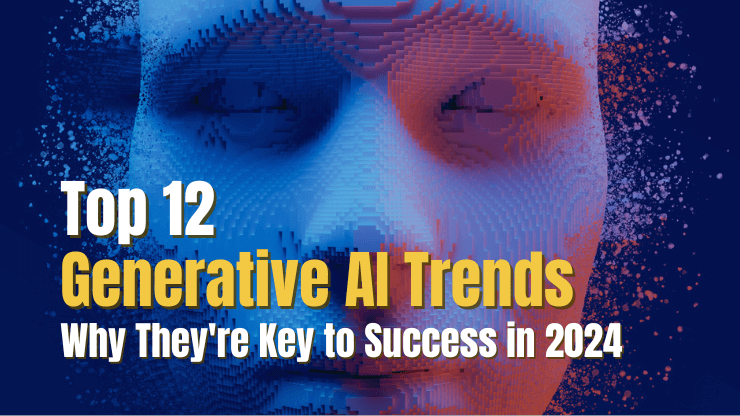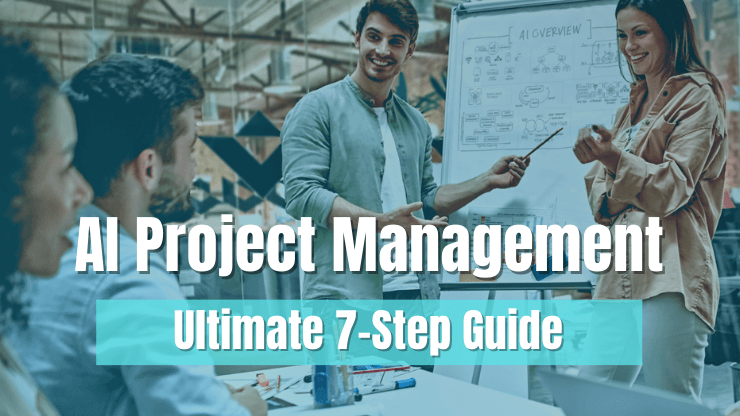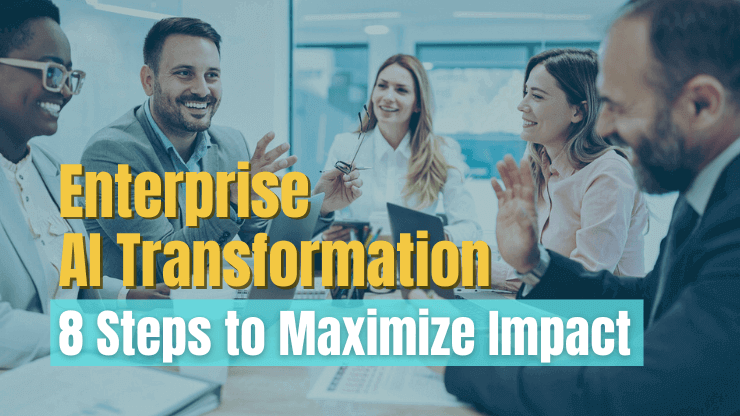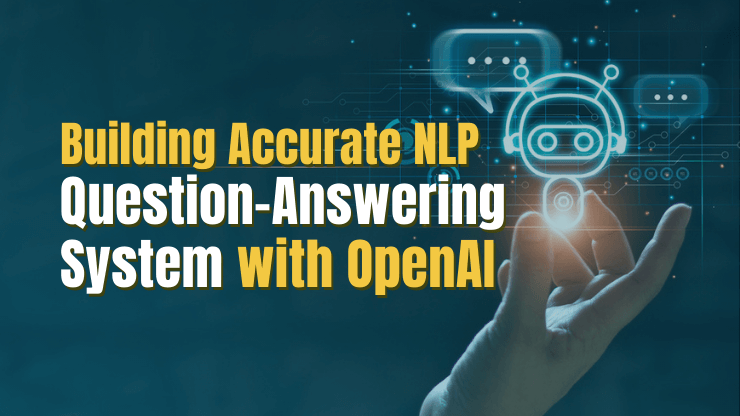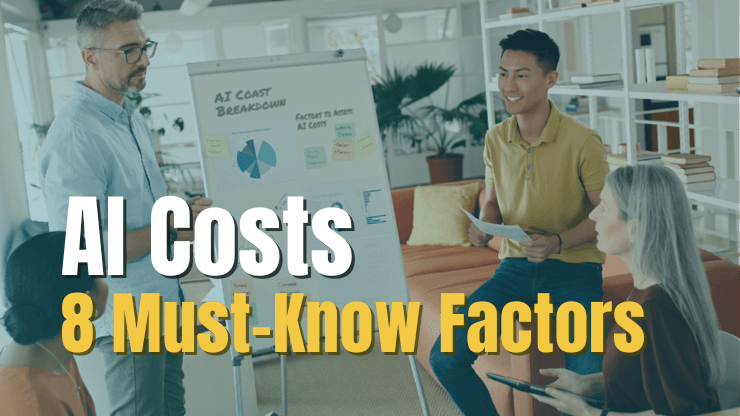Generative AI is undergoing a swift evolution, shifting from an intriguing technological prospect to an essential driver of business innovation and competitive advantage. This shift is underscored by the significant uptake of Gen AI tools across industries, with one-third of organizations already integrating these technologies into their operations and 40% preparing to increase their AI investment in response to Gen AI's advancements.
This growing momentum reflects a deeper understanding within the business community of how generative AI is reshaping the landscape of success. In this article we’ll delve into this and look at the top 12 generative AI trends of 2024. We’ll highlight the critical role of generative AI across industries and verticals as well as provide concrete resources for your business to leverage the value of generative AI for enhanced innovation, operational efficiency and business success.
- The state of generative AI models
- Top 12 generative AI trends in 2024
- 1. Generative AI spending grows substantially
- 2. Open source AI models overtake proprietary models
- 3. Generative AI becomes embedded in nearly all business software
- 4. AI assistants significantly reduce administrative work
- 5. Generative AI enables more accessible data analytics
- 6. Employees across functions expect training to work with AI
- 7. Generative question answering (GQA) enhances document processing
- 8. Generative AI alleviates strain on customer support
- 9. Product innovation accelerated by generative AI
- 10. Highly personalized products and services become the norm
- 11. Generative AI simplifies tailored learning experiences
- 12. Copyright battles over AI generated content escalate
- Conclusion
The state of generative AI models
Generative AI models have seen remarkable maturation in recent years. Less than 10 years ago, the idea that these models could produce writing or code at a human level seemed far-fetched. Yet, by 2022, the landscape had shifted dramatically, with generative models achieving—and in many cases surpassing—human-like capabilities. As shown below, this progress has not only continued but accelerated, with today's models like Open AI’s GPT-4 pushing the boundaries beyond text into code and image generation.
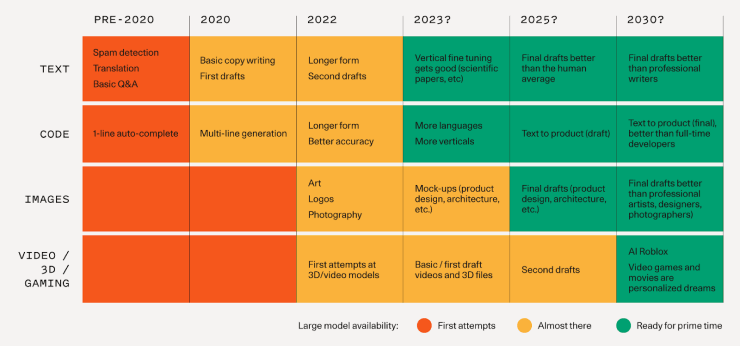
The swift evolution and current state of generative AI models has been made possible thanks to decreasing computing costs, strong innovative research in the AI community, and expanded model access to beta and open-source platforms. And, investment in generative AI models is not slowing down either. In fact, the market is projected to grow from just $40 billion in 2022 to over $1.3 trillion over the next 10 years.
Today the generative AI models are not just enhancing productivity in fields like coding and digital content creation; they are also being fine-tuned for specialized applications in industries such as healthcare, finance, and entertainment.
Top 12 generative AI trends in 2024
In 2024, generative AI continues to shape the technological landscape, driving innovation and transforming industries in unprecedented ways. These top 12 AI trends for 2024 underscore the strategic importance of artificial intelligence in enhancing business operations, enabling new value propositions, and fostering competitive advantages across various sectors:
Generative AI spending grows substantially
In its Technology, Media, and Telecom Predictions 2024, Deloitte declares that “generative AI gains boardroom momentum” and says that generative AI will move from a “concept buzzing in enterprise circles to a reality reshaping industries.”
While forecasts are not consistent for generative AI spending in 2024, it’s clear that momentum is continuing, and spending is growing substantially. Some highlights:
- IDC shows that enterprises will more than double their spending on GenAI solutions year over year from 2023 to 2024.
- SpiceWorks reports that 66% of companies are planning to increase their IT budgets in 2024
- In an MIT Tech Review survey of 600 firms, almost half said they would boost spending on data infrastructure and AI by more than 25% in the coming year.
- According to Deloitte, Enterprise software companies are expected to experience a revenue uplift of $10 billion by the end of 2024 as a result of investment in generative AI.
- Bloomberg Intelligence projects that the generative AI technology market will explode, growing to $1.3 trillion over the next 10 years from a market size of just $40 billion in 2022:
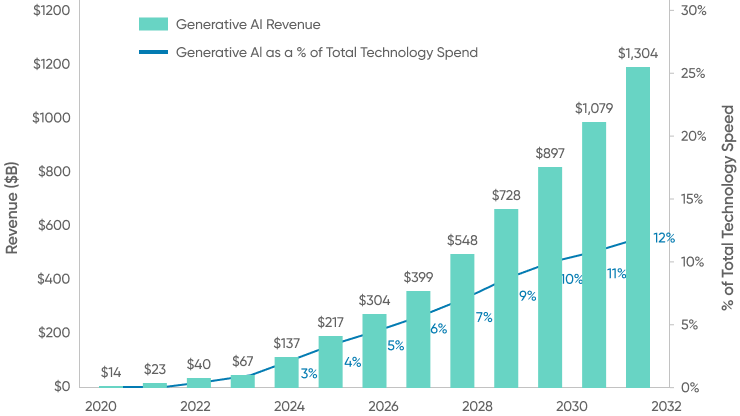
Open source AI models overtake proprietary models
The landscape of generative AI is witnessing a significant shift as open-source models start to rival their proprietary counterparts. A striking example of this trend is Mistral AI, a Paris-based startup that recently closed a massive $415 million funding round. Co-founded by Google’s DeepMind and Meta alums, Mistral underscores a growing confidence in the open-source approach to AI development.
Mistral AI's commitment to an "open, responsible, and decentralized approach to technology" not only differentiates it from the likes of OpenAI and Google but also aligns with a broader push for transparency and accessibility in AI development.
And ARK Invest’s research confirms that the performance gap between private and open-source models is narrowing, as we see below:
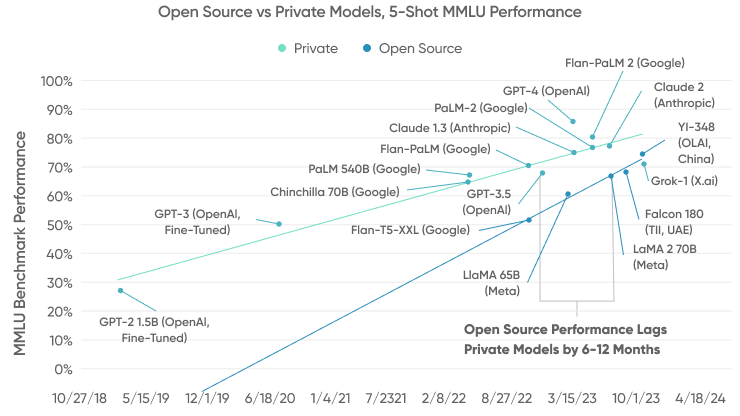
Generative AI becomes embedded in nearly all business software
In line with increased spending on AI, Deloitte predicts that generative AI will become integral to “nearly all” enterprise software offerings in 2024. This trend of embedding AI into familiar enterprise tools represents a low-barrier approach to adopting artificial intelligence in businesses. Instead of requiring new generative AI tools or complex integrations, these AI capabilities are enhancing existing software, making them more intuitive and efficient. A few key examples include:
- Business productivity tools like Microsoft 365 Copilot, Google Duet AI enhance productivity across Microsoft 365 apps and offer advanced data interpretation, content creation, and collaboration.
- CRMs like Salesforce Einstein provide advanced AI capabilities across its customer relationship management (CRM) platform, enhancing analytics, customer service, and marketing automation.
- Atlassian, which owns Jira, Confluence, and Trello incorporates AI in its software suite to optimize project management, automate tasks, and improve decision-making processes.
- Marketing and creativity tools like Canva, the Adobe Suite, and Hubspot integrate AI directly into their software for enhanced creativity and productivity.
- Customer service management and ticketing tools like Zendesk provide AI-powered support to customer service agents.
AI assistants significantly reduce administrative work
AI is revolutionizing administrative tasks, streamlining complex processes, and offering smarter ways to handle day-to-day office work. By automating repetitive tasks, an AI assistant can free up valuable time, allowing professionals to focus on more strategic activities. For example, Gen AI is being used for:
- Internal communications: Nearly half (46%) of business owners use AI solutions to craft internal communications.
- Email management: Through precise extraction of details from emails and attachments, AI tools like Mailbutler can summarize emails and help you compose responses in just a few clicks.
- Schedule/calendar management: AI-powered tools like Clockwise and Reclaim.ai optimize meeting scheduling and daily task management.
- Note taking: Platforms like Mem.ai leverage AI to efficiently capture and organize meeting notes, enhancing productivity during follow-ups.
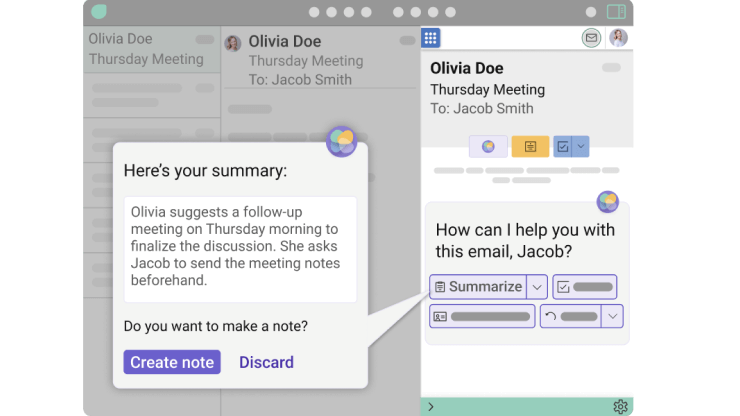
Generative AI enables more accessible data analytics
Another key application of generative AI is data analytics, and in 2024, we’re seeing innovations that are expanding data accessibility thanks to Gen AI’s ability to understand and process natural language inputs and generate natural language responses. For example, instead of relying on a data analyst or data analysis tool power user to create a new data pivot or weed through vast data sets, any business user could “chat with their data” in natural language.
As this subset of AI advances, we’ll see a greater democratization of data analytics where it is commonplace to interact with business data in more intuitive, natural ways.
As businesses contend with growing volumes of data, generative AI's scalability becomes a critical feature. It manages and analyzes large datasets efficiently, maintaining consistent performance and the ability to derive insights from extensive information pools.
Microsoft’s “chat with your data” solution accelerator offers a template for end-to-end RAG pattern implementation using the "Retrieve-then-read" interaction pattern. This solution accelerator combines the GPT model in Azure OpenAI Service with an Azure AI Search index generated from your data, integrating them into a web application to deliver a natural language interface for search queries.
Employees across functions expect training to work with AI
AI demands a new kind of in-the-job training, but only 1 in 10 employees have been offered AI training in the past year. This disparity emphasizes the need for a more inclusive and extensive training program across various levels of an organization as businesses seek to expand the use of AI across various business operations.
Sander van’t Noordende, CEO of Randstad has said that “AI is here to stay and the benefits of it are very clear – our data shows that employees stand ready to embrace it for their own gain too. Successful organizations will be those that leverage this readiness and harness the opportunities of AI in their workforce.”
In 2024, businesses are taking action and reducing barriers to AI adoption, investing in AI training courses like “AI for Everyone” from the founder of DeepLearning.ai and helping employees in all roles make use of AI, whether to enhance their creativity, streamline their operations, or reduce errors. We’re in the era of nearly every employee - regardless of department or job function - expecting AI training.
Generative question answering (GQA) enhances document processing
Generative question answering (GQA) is revolutionizing business document management through the use of sophisticated machine learning technologies. This approach enables generative AI systems to answer queries posed in natural language, drawing directly from document contents.
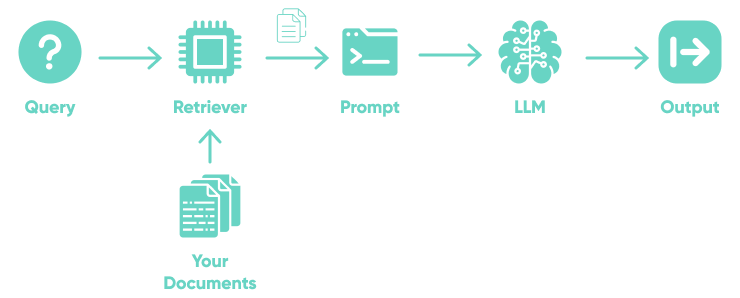
Generative QA transcends traditional keyword search limitations by utilizing Large Language Models (LLMs) for a deeper understanding and interpretation of data, producing not only precise but contextually nuanced responses. This use of LLMs fosters the development of more interactive and intuitive systems that go beyond mere data retrieval to comprehend and interpret information. Such capability facilitates handling intricate questions across various fields, markedly changing our engagement with and extraction of data. Key developments include:
- Google launched Document AI, which allows developers to build an “Ask your documents” tool for employees by leveraging text embedding models and PaLM 2.
- JPMorgan's DocLLM, offers an alternative to general multimodal models as a lightweight extension of traditional LLMs that is specifically designed to handle complex documents like PDFs. It has shown to provide a 15%+ improvement in understanding form-based documents compared to leading models.
We’ll likely see advancements in intelligent document processing solutions on the market as well as new specialized LLMs emerging that offer advanced capabilities tailored to the needs of GQA applications.
Read More: Intelligent Document Solutions
Generative AI alleviates strain on customer support
According to a recent report by Deloitte, 80% of contact centers are actively engaging in some stage of AI deployment, with 81% of contact center executives investing in generative AI for agent-enabling technologies to improve the agent experience and operational efficiency.
Whether it’s a customer-facing generative AI bot or voice assistant or an AI tool to help customer support agents do their job more efficiently, AI is poised to drastically reduce the strain on customer support.
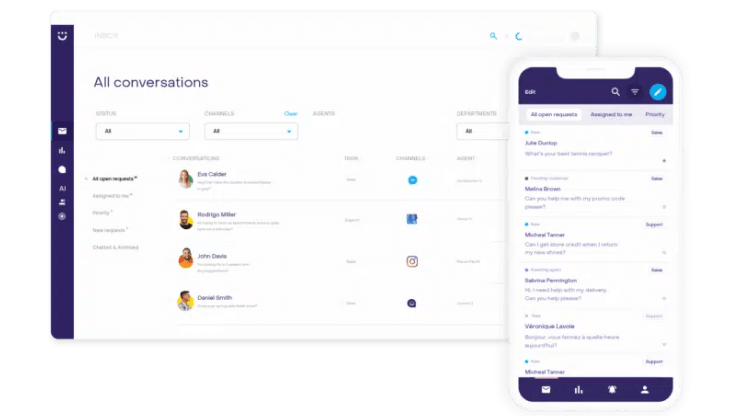
Furthermore, because of advancements in LLMs like GPT-4V, which now have the ability to process images and documents along with text, we’re expecting a new era of powerful generative AI-enabled support bots to further enhance customer experiences, provide accurate, timely support, and reduce the strain on live agents.
Product innovation accelerated by generative AI
Harvard business review reported that “one of the biggest opportunities generative AI offers is to augment human creativity and overcome the challenges of democratizing innovation.” Generative AI is clearly poised to assist with creative work, and product innovation is no exception. In 2024, we’re seeing a major shift in how businesses approach product design and development, making the process more creative, data-driven, and efficient. Key developments include:
- Google is promoting how Vertex AI Search, Looker, and Dialogflow can be used to transform the product innovation process and shorten the time from idea to shipping product.
- Familiar 3D modeling and product design tools like Autodesk are now incorporating AI directly into their products.
- Tools like Toggle3D.ai are emerging that can be utilized to test design viability before generating physical prototypes.
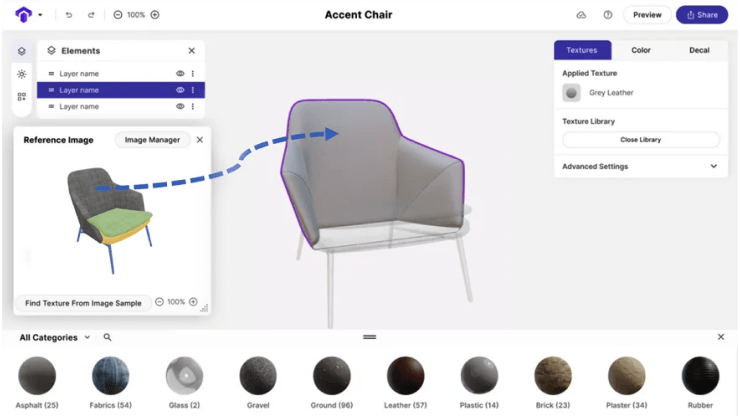
Highly personalized products and services become the norm
According to a report by Adobe, 72% of global consumers believe that generative AI will improve their customer experience. And one of the key ways we’re seeing this be made possible is through AI-driven, highly personalized products and services.
Generative AI is significantly reshaping the way businesses offer highly personalized products and services. Instead of basic recommendations or light personalization based on algorithms, AI is enabling hyper-personalization* *on the fly. AI tools can review user profiles or other data, feed it through AI algorithms and through generative AI deliver hyper-personalized individual experiences that drive higher levels of engagement, customer loyalty, and satisfaction.
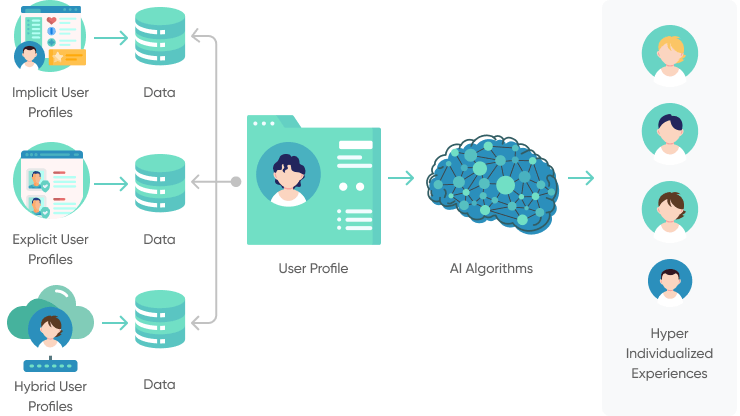
Generative AI simplifies tailored learning experiences
In January 2024, Arizona State University became the first higher education institution to collaborate with OpenAI. This partnership introduces the sophisticated functionalities of ChatGPT Enterprise into the realm of higher education, establishing a novel benchmark for universities aiming to augment learning, foster creativity, and improve student achievements through:
- Recommendation engines: AI can be used to analyze user provided information and suggest customized learning content.
- Adaptive learning paths: AI is being used to facilitate dynamic learning journeys and combine structured paths with flexible "choose your own adventure" options.
- Real-time assessments: Machine learning algorithms can refine these learner paths, suggest repetitions or new content based on ongoing assessment results.
Copyright battles over AI generated content escalate
Experts anticipate that the upcoming year will witness significant legal outcomes related to copyright issues in AI, especially concerning the utilization of copyrighted material for AI model training without authorization and remuneration.
This year has already seen the filing of potential class-action lawsuits by various authors against the use of their works in AI training datasets. Notable plaintiffs include best-selling authors like John Grisham and George R.R. Martin of "Game of Thrones" fame, alongside comedian Sarah Silverman and former Arkansas governor Mike Huckabee. Similar legal actions have been initiated by copyright owners in other domains, including visual artists, music publishers, stock-photo provider Getty Images and the New York Times.
The escalating conflict underscores a growing tension between the advancement of AI technologies and local and international laws. Businesses must take a proactive approach to developing AI governance frameworks and guidelines to navigate the intersection of AI innovation and copyright protection.
Conclusion
The rise of generative AI represents a turning point for businesses, opening up unprecedented opportunities for growth and innovation. Our exploration of the 2024 generative AI trends underscores the critical role these technologies play in keeping companies at the forefront of their industries. For businesses aiming to excel in the digital age, integrating generative AI into their strategies is not just beneficial—it's essential for maintaining a competitive edge in an increasingly tech-driven market.

